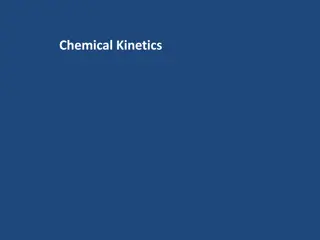Understanding Exothermic and Endothermic Reactions in Chemistry
In chemistry, it's essential to differentiate between exothermic and endothermic reactions based on the direction of heat flow. Exothermic reactions release heat to the surroundings, while endothermic reactions absorb heat to proceed. Through examples like the combustion of propane and the formation of nitrogen monoxide, this article explores the concepts of heat exchange in chemical reactions. Additionally, it delves into the calculations of enthalpy using Hess's Law, emphasizing the broader implications of heating systems in chemical processes.
Download Presentation

Please find below an Image/Link to download the presentation.
The content on the website is provided AS IS for your information and personal use only. It may not be sold, licensed, or shared on other websites without obtaining consent from the author. Download presentation by click this link. If you encounter any issues during the download, it is possible that the publisher has removed the file from their server.
E N D
Presentation Transcript
Chemistry Chemistry 1 1st stclass class Water Resources department Water Resources department By: Israa Murtadha Hameed Israa Murtadha Hameed
THERMOCHEMISTRY THERMOCHEMISTRY 5th lecture By: Israa Murtadha Hameed Israa Murtadha Hameed
Exothermic and Endothermic Reactions Exothermic and Endothermic Reactions When observing the heats of chemical reactions it is important to know which way the heat is flowing in the chemical reaction. Is the heat being generated by the chemical reaction? Is heat required in order for the chemical reaction to proceed? The following definitions are agreed upon conventions describing the flow of heat in chemical reactions. Israa Murtadha Hameed
Exothermic Reactions Exothermic Reactions Chemical reactions that release heat to the surroundings are considered to be exothermic reactions. Let s look at the familiar combustion reaction of propane (C3H8). C3H8 + 5O2 3CO2 + 4H2O In truth this reaction is missing one very important product. C3H8(g)+ 5O2(g) 3CO2(g)+ 4H2O(g) + Heat When one mole of propane is burned it releases 2028.8 kJ of heat to the surroundings. Due to convention the heat of reaction for the combustion of propane is expressed as -2028.8 kJ mol-1. The negative sign is from the perspective of the reactants. The propane and the oxygen lost heat as a consequence of the combustion reaction. Israa Murtadha Hameed
Endothermic Reactions Endothermic Reactions Chemical reactions that need to absorb heat from the surroundings in order to proceed are known as endothermic reactions. Let s look at the formation of nitrogen monoxide (NO) form nitrogen (N2) and oxygen (O2), N2(g) + O2(g) 2NO(g) Again this chemical equation does not tell the entire story. The reaction will not proceed unless energy, in the form of heat, is added to the reaction. N2(g) + O2(g) + Heat 2NO(g) Israa Murtadha Hameed
It is necessary for N2 and O2 to absorb 90.37 kJ mol-1 in order to react to form one mole of NO. In the above balanced chemical equation twice that value, 180.74 kJ, were required to form two moles of NO. By convention the heat of reaction for the formation of NO from N2 and O2 is 90.37 kJ mol-1. This number is positive since the N2 and O2 are seen to have gained heat Israa Murtadha Hameed
Enthalpy Calculations: Hess Law Enthalpy Calculations: Hess Law When an object or system of objects are heated more is going on than just the heating. If you heat a beaker of water that is open to ambient pressure the volume of the water will increase. This is a form of work know as P v work. Rather than deal with this component of thermochemistry directly, a new value known as enthalpy (H) was developed. Standard enthalpies of formation for many substances were experimentally determined and listed in tables. It is easy to use these listed values to calculate the change in enthalpy for a reaction using the following formula. Israa Murtadha Hameed
Hess Hess Law Law Hess Law uses standardized enthalpies of formations for reactants and products in order to calculate the change in enthalpy for a chemical reaction. Israa Murtadha Hameed
Hess Law simply states that if you subtract the standard energies (enthalpies) of formation of the reactants from the standard energies of formation of the products that whatever is left is the energy change for that reaction. If the value is negative, that means that energy is released to the surroundings and the reaction is exothermic. If the value is positive, that means that the energy is absorbed from the environment and the reaction is endothermic. Israa Murtadha Hameed
The following table lists standard enthalpies of formations for some compounds. This table can be used to work the exercises that follow Israa Murtadha Hameed
Exercises Exercises Exercise: 1 Balance the combustion reaction for acetylene (C2H2) and calculate the change in enthalpy for the reaction. = [2(-393.5) + (-241.816)] [(54.2) + 2.5(0)] = -787 241.816 54.2 = -1083 kJ mol-1 A negative value indicates an exothermic reaction. It s on fire! Israa Murtadha Hameed
Exercises Exercises Exercise: 2 Calculate the change in enthalpy for the dissociation of ammonium chloride (NH4Cl) to ammonia (NH3) and hydrogen chloride (HCl). = [(-80.8) + (-167.2)] [-314.55] = -248 + 314.55 = 66.6 kJ mol-1 A positive value indicates an endothermic reaction. Energy is required for the reaction to occur. In fact if you were holding a beaker or test tube where this reaction was occurring you would not only smell the ammonia but the reaction vessel would feel cool. Israa Murtadha Hameed
States of Matter States of Matter The three principle states of matter are solid, liquid, and gas. Below are listed the basic definitions that differentiate these three states of matter from one another. Solids: Solids are materials that have a definite shape and volume. The arrangement of atoms or molecules in a solid are fixed. The movement of the atoms or molecules in a solid are very slow. Liquids: Liquids are materials that have a definite volume but an indefinite shape. The arrangement of liquid atoms or molecules is random. The shape of a liquid is determined by the container holding the liquid. The movement of atoms and molecules in a liquid is faster than they are in a solid. Israa Murtadha Hameed
States of Matter States of Matter Gasess : Gases are materials that have an indefinite shape and volume. Both the shape and the volume of a gas are determined by the shape and the volume of the container holding the gas. The arrangement of atoms or molecules in a gas is random. The movement of atoms or molecules in a gas is very rapid Israa Murtadha Hameed
Changes of States in Matter Changes of States in Matter Israa Murtadha Hameed
States of Matter States of Matter 1. Melting is the change of state of a substance when that substance changes from a solid to a liquid. This conversion from solid to liquid is dependent on the amount of energy the substance must gain to allow freedom of movement of the molecules or atoms of that substance. The melting point of a substance is that temperature at which the solid and liquid phases of the substance exist in equilibrium. 2. Freezing is the change of state of a substance when that substance changes from a liquid to a solid. This conversion from liquid to solid is dependent on the amount of energy the substance must lose to prohibit freedom of movement of the molecules or atoms of that substance. The freezing point of a substance is the same as the melting point of that substance in nearly all substances. Since some substances have the ability to supercool, the melting point is considered a more valid property of a substance than the freezing point. Israa Murtadha Hameed
States of Matter States of Matter 3. Vaporization is the change of state of a substance when that substance changes from a liquid to a gas. Molecules at the surface of a liquid can have enough energy to escape the liquid and exist in a vapor or gas phase just above the surface of the liquid. Molecules in the vapor phase of a liquid can lose enough energy to return to liquid phase. The pressure at which the number of molecules or atoms of a liquid are at equilibrium, as many entering the vapor phase as leaving it, is known as the vapor pressure of the liquid. When enough energy is added to a liquid to increase the vapor pressure to ambient pressure the liquid is said to have reached its boiling point. Israa Murtadha Hameed
States of Matter States of Matter 3. Vaporization is the change of state of a substance when that substance changes from a liquid to a gas. Molecules at the surface of a liquid can have enough energy to escape the liquid and exist in a vapor or gas phase just above the surface of the liquid. Molecules in the vapor phase of a liquid can lose enough energy to return to liquid phase. The pressure at which the number of molecules or atoms of a liquid are at equilibrium, as many entering the vapor phase as leaving it, is known as the vapor pressure of the liquid. When enough energy is added to a liquid to increase the vapor pressure to ambient pressure the liquid is said to have reached its boiling point. Israa Murtadha Hameed
States of Matter States of Matter 4. Condensation: is the change of state of a substance when that substance changes from a gas to a liquid. Condensation, obviously the reverse of evaporation, occurs in the vapor phase of a liquid when vapor molecules or atoms return to the liquid phase. 5. Sublimation: is the change of state of a substance when that substance changes from a solid to a gas. A good example of sublimation is the reduction in size of an icicle hanging from the eave of your house. The icicle reduces in size without being broken or melting. Where did the missing ice go? It was converted, using the energy of the sun, directly from a solid to a gas. Israa Murtadha Hameed
States of Matter States of Matter 6. Deposition: is the change of state of a substance when that substance changes from a gas to a solid. Everyone, in cold climates, has had to clean ice and/or snow from the windscreen of their car at sometime or other. The hardest of these to remove from your windscreen is the very thin layer of ice that appeared when their was no snow, no freezing rain or mist, and no freezing fog. Where did that ice come from? It was deposited as a solid on your windscreen from the gaseous molecules of water in the air. Israa Murtadha Hameed
Any Questions? Israa Murtadha Hameed























